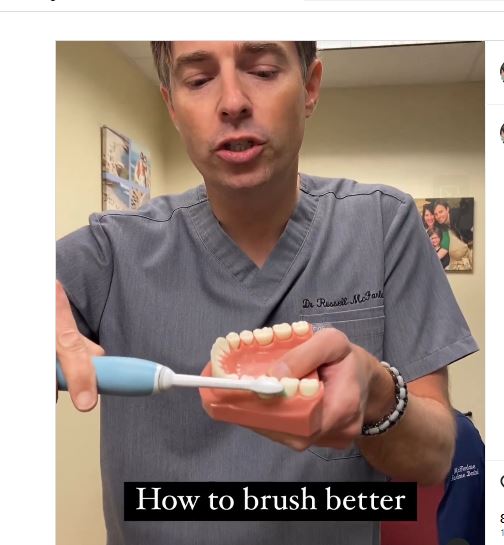There are so many ways to stay healthy: flossing, and brushing. Sometimes adjuncts such as water flossers, and rinses are appropriate as well.

Floss Daily.
1. Floss daily
Flossing is great because it breaks up the biofilm. The long-term benefit is the ripple-out health effects of improving full body health.
- The plaque around the gums in perio patients comprises bacteria that is also found in foam cells around the heart of patients with heart disease.
- Breaking up those adhesions to the teeth reduces inflammation, by reducing c-reactive protein (cRP)
- Likewise, it can improve A1C numbers in diabetic patients, making diabetes management easier.
2. Eat healthy
As it relates to health, eating a balanced diet of protein, fat, and limiting the amount of sugar is a good guideline. As it relates to dentistry, when you consume sugar, you should try to limit this to mealtimes. Every time you consume sugar, your mouth undergoes a pH drop event that lasts approximately 30-minutes, during which your teeth are more susceptible to caries.
- For the 30-minutes after a sugar exposure in your mouth, the bacteria are feasting and creating acid.
- The acid produced during this time drops the pH in your mouth below the critical 5.5 pH.
- While the pH is below 5.5, your teeth are demineralizing.
- A fluoridated toothpaste, can be used to remineralize and offset this demineralization event, bringing balance in the mouth.

Brush 2-min morning and 2-min at night

Regular check-ups help catch problems early.
3. Regular checkups
We recommend a 6-month dental hygiene check-up. Each check-up serves to update the health of your mouth, including your gums and your teeth.
- Some people may require cleanings at a 3-month interval, or 4-month interval. This more frequent visit cycle is appropriate for patients with periodontal disease.
- Check-up X-rays are taken at a 1-year interval, although some patients may be low risk for both caries and periodontal disease and can have bitewing x-rays at a 2-year interval.
- Probing around the gums is the best way to discover if there is looming gum problems, and these probing depths must be checked and later re-checked over time to keep tabs on the gum health.
- Cavities can be identified on x-rays, visually, through tactile exam, or even other ways.
